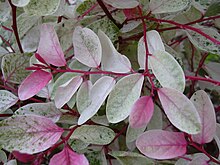|
Species of flowering plant
| Breynia disticha
|

|
Scientific classification 
|
| Kingdom:
|
Plantae
|
| Clade:
|
Tracheophytes
|
| Clade:
|
Angiosperms
|
| Clade:
|
Eudicots
|
| Clade:
|
Rosids
|
| Order:
|
Malpighiales
|
| Family:
|
Phyllanthaceae
|
| Genus:
|
Breynia
|
| Species:
|
B. disticha
|
| Binomial name
|
Breynia disticha
J.R.Forst. & G.Forst.
|
| Synonyms[1]
|
- Breynia disticha var. genuina Müll.Arg.
- Breynia axillaris Spreng.
- Melanthesa neocaledonica Baill.
- Melanthesa neocaledonica var. forsteri Müll.Arg.
- Breynia disticha var. neocaledonica (Baill.) Müll.Arg.
- Phyllanthus nivosus W.Bull
- Agave roseopictus Van Geert
- Phyllanthus atropurpureus Van Geert
- Phyllanthus nivosus roseopictus Regel
- Phyllanthus roseus-pictus Hovey
- Breynia nivosa (W.Bull) Small
- Phyllanthus sandwicensis var. hypoglaucus H.Lév.
- Breynia nivosa var. roseopicta (Regel) F.Br.
- Breynia disticha f. nivosa (W.Bull) Croizat ex Radcl.-Sm.
|
Breynia disticha, commonly known as the snowbush, is a plant in the family Phyllanthaceae, first described in 1776. It is native to New Caledonia and Vanuatu in the western Pacific, but naturalized on a wide assortment of other islands around the world (West Indies, São Tomé, Seychelles, Chagos Islands, Bonin Islands, Norfolk Island, Fiji, Line Islands, Society Islands, Hawaii, etc.), as well as in the U.S. state of Florida.[1][2][3][4][5][6][7]
Breynia disticha presumably is pollinated by leafflower moths (Epicephala spp.) in its native range, like other species of plants in the genus Breynia.[8][9] Leafflower moths have been reared from fruit of this species in New Caledonia.
The fruit of Breynia are presumed to be toxic, causing liver injury.[10]
References
- ^ a b Kew World Checklist of Selected Plant Families
- ^ Govaerts, R., Frodin, D.G. & Radcliffe-Smith, A. (2000). World Checklist and Bibliography of Euphorbiaceae (and Pandaceae) 1-4: 1-1622. The Board of Trustees of the Royal Botanic Gardens, Kew.
- ^ Figueiredo, E., Paiva, J., Stévart, T., Oliveira, F. & Smith, G.F. (2011). Annotated catalogue of the flowering plants of São Tomé and Príncipe. Bothalia 41: 41-82.
- ^ Friedmann, F. (1994). Flore des Seychelles Dicotylédones: 1-663. ORSTOM éditions.
- ^ de Lange, P.J., Gardner, R.O., Sykes, W.R., Crowcroft, G.M., Cameron, E.K., Stalker, F., Christian, M.L. & Braggins, J.E. (2005). Vascular flora of Norfolk Island: some additions and taxonomic notes. New Zealand Journal of Botany 43: 563-596.
- ^ Wester, L. (1985). Checklist of the vascular plants of the Northern Line Islands. Atoll Research Bulletin 287: 1-38.
- ^ "Breynia disticha in Flora of North America @". Efloras.org. Retrieved 2022-05-01.
- ^ Kawakita, A.; Kato, M. 2004. Obligate pollination mutualism in Breynia (Phyllanthaceae): further documentation of pollination mutualism involving Epicephala moths (Gracillariidae). American Journal of Botany. 91: 1319–1325
- ^ Zhang, J.; Wang, S.; Li, H.; Hu, B.; Yang, X.; Wang, Z. 2012. "Diffuse coevolution between two Epicephala species (Gracillariidae) and two Breynia species (Phyllanthaceae). PLOS ONE. 7: e41657.
- ^ Kawakita, A.; Kato, M. 2009. "Repeated independent evolution of obligate pollination mutualism in the Phyllantheae-Epicephala association." Proceedings of the Royal Society B. 276: 417–426.
|
